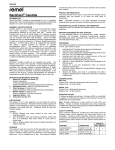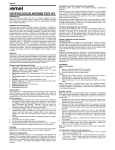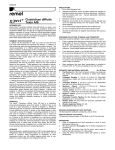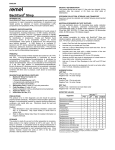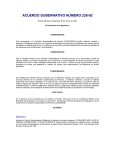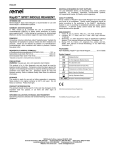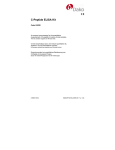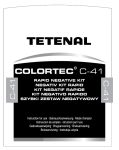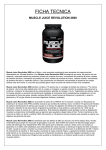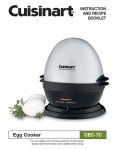Download CANDIDA ALBICANS TEST KIT
Transcript
ENGLISH CANDIDA ALBICANS TEST KIT INTENDED USE Remel Candida Albicans Test Kit is recommended for use in qualitative procedures to aid in the identification of Candida albicans by detection of the enzymes L-proline aminopeptidase and β-galactosaminidase in yeast cells cultured on laboratory media. SUMMARY AND EXPLANATION C. albicans is the species of yeast most frequently isolated from clinical specimens. Historically, C. albicans has been presumptively 1 Studies, however, have identified using the germ tube test. demonstrated that up to 5% of C. albicans clinical isolates are germ tube negative. Additionally, early pseudohyphae of Candida tropicalis 2 may be confused with germ tube formation. In 1987, Perry and Miller reported the use of an umbelliferyl-labeled compound (Nacetyl-β-D-galactosaminide) to differentiate C. albicans and C. tropicalis. This test was later modified to include the detection of Lproline aminopeptidase to increase the test specificity. Also, the substitution of a nitrophenyl-labeled compound provided a colorimetric rather than fluorometric endpoint for the detection of β3 galactosaminidase. While other species of yeasts were found to be positive for L-proline aminopeptidase or β-galactosaminidase, C. albicans was positive for both enzymes. This substrate combination provides a rapid, non-microscopic method to aid in the 4 identification of C. albicans. PRINCIPLE The substrates, ρ-nitrophenyl-N-acetyl-β-D-galactosaminide (NGL) and L-proline-β-naphthylamide (PRO) are impregnated on each Candida Albicans Test Kit disk. The hydrolysis of NGL by the enzyme β-galactosaminidase is indicated by the development of a yellow color due to the liberation of ρ-nitrophenol. The addition of Sodium Hydroxide, 0.3% enhances the reaction by creating alkaline conditions. If the PRO substrate has been hydrolyzed by L-proline aminopeptidase, a red color develops due to the reaction of βnaphthylamine with ρ-dimethylaminocinnamaldehyde. REAGENTS AND MATERIALS SUPPLIED 1. Candida Albicans Test Kit Disks (1 vial of 50) Reactive Ingredient: ρ-nitrophenol-N-acetyl-β-D-galactosaminide (NGL) and L-proline-β-naphthylamide (PRO) 2. Color Developer (1 bottle, 4.5 ml) Reactive Ingredient: 0.01% ρ-dimethylaminocinnamaldehyde 3. Sodium Hydroxide, 0.3% (1 bottle, 4.5 ml) 4. Plastic Tubes with Caps (50) 5. Applicator Sticks (1 vial of 50) 6. Instructions for Use (IFU) PRECAUTIONS 1. This product is for In Vitro diagnostic use and should be used by properly trained individuals. 2. Standard precautions should be taken against the dangers of microbiological hazards by properly sterilizing specimens, containers, and test materials after use. 3. Directions should be read and followed carefully. 4. Caution! The Color Developer is toxic and may cause harm to the environment. Harmful by inhalation, contact with skin or eyes, or if swallowed. May impair fertility or cause harm to unborn child. 5. Refer to the Material Safety Data Sheet for detailed information on reagent chemicals. 6. Reagents are provided at the necessary working strength and should be dispensed directly from the dropper bottles. Do not dilute reagents. 7. Do not interchange reagents between kits of different lots. STORAGE Store product in the dark in its original container at 2-8°C until used. Do not freeze or overheat. Allow product to equilibrate to room temperature before use. Do not incubate prior to use. PRODUCT DETERIORATION This product should not be used if (1) the color of the disks has changed from white, (2) the expiration date has passed, or (3) there are other signs of deterioration. Protect disks from moisture by removing from the vial only those disks necessary for testing. Promptly replace the cap and return the vial to 2-8°C. Note: Precipitate formation or color variation from straw to pink in the Color Developer is common and does not affect test performance. SPECIMEN COLLECTION, STORAGE, AND TRANSPORT Specimens should be collected and handled following recommended 5 guidelines. MATERIALS REQUIRED BUT NOT SUPPLIED (1) Loop sterilization device, (2) Inoculating loop, swabs, collection containers, (3) Incubators, alternative environmental systems, (4) Supplemental media, (5) Quality control organisms, (6) Forceps, (7) Demineralized water, (8) Micropipette (5-10 µl) or microbiological loop (10 µl). PROCEDURE Test isolates should be less than 96 hours old and growing on commonly used media, such as blood agar, Sabouraud dextrose agar, or mycobiotic agar. Ensure the test isolate is in pure culture or select colonies that are well-isolated from surrounding organisms. 1. Using forceps remove a Candida Albicans Test Kit disk from the vial and place it in one of the tubes provided. 2. Add one drop of demineralized water to moisten the disk (~10 µl). Do not oversaturate. 3. With an applicator stick (provided) remove a heavy visible paste of the test isolate and rub it into the disk. 4. Cap the tube and incubate at 35-37°C for 30 minutes. 5. After incubation, add one drop of Sodium Hydroxide, 0.3% and examine tube against a white background for a distinct yellow color. Record the presence or absence of color. 6. Add one drop of the Color Developer and examine for a pink to red color within one minute. Record the presence or absence of color. INTERPRETATION NGL: Positive Test - Distinct yellow color after addition of Sodium Hydroxide, 0.3% Negative Test - No yellow color after addition of Sodium Hydroxide, 0.3% PRO: Positive Test - Pink to red color within one minute of adding Color Developer Negative Test - No color change or slight yellow color within one minute of adding Color Developer EXPECTED VALUES C. albicans is positive for both tests. If either the NGL or the PRO test is negative, or if both tests are negative, further testing is required for identification of the yeast isolate. Note: Candida dubliniensis is also positive for both NGL and PRO. Growth at elevated temperatures and colony morphology on differential media have been reported to facilitate differentiation of C. 6,7 albicans and C. dubliniensis. QUALITY CONTROL All lot numbers of Candida Albicans Test Kit have been tested using the following quality control organisms and have been found to be acceptable. Testing of control organisms should be performed in accordance with established laboratory quality control procedures. If aberrant quality control results are noted, patient results should not be reported. CONTROL Candida albicans ® ATCC 60193 Candida krusei ® ATCC 14243 INCUBATION Aerobic, 30 min. @ 35-37°C Aerobic, 30 min. @ 35-37°C RESULTS NGL PRO + + - - ENGLISH LIMITATIONS 1. False-negative reactions may occur with Candida Albicans Test Kit if inadequate inoculum is used. 2. C. dubliniensis, first described in 1995, also produces germ tubes 8 Growth at elevated temperatures and and chlamydospores. morphology on differential media have been shown to facilitate 6,7 differentiation of C. albicans and C dubliniensis. 3. This test is only part of the overall scheme for identification of yeasts. Further testing is required for definitive identification. 1,5 Consult appropriate references for further instructions. PERFORMANCE CHARACTERISTICS In a comparative study, Candida Albicans Test Kit was evaluated in parallel with conventional methods and a commercially available identification system. A total of 583 fresh clinical isolates were tested, including C. albicans (303 isolates) and 10 other species of yeasts. The study results demonstrated C. Albicans Test Kit has a 9 sensitivity of 98.7% and a specificity of 99.6%. 8. 9. Sullivan, D.J., T.J. Westerneng, K.A. Haynes, D.E. Bennett, and D.C. Coleman. 1995. 141:15071521. Crist, A.E., Jr., T.J. Dietz, and K. Kampschroer. 1996. J. Clin. Microbiol. 34:2616-2618. PACKAGING REF R30851401, Candida Albicans Test Kit......................50 Tests/Kit Symbol Legend REF Catalog Number IVD In Vitro Diagnostic Medical Device LAB For Laboratory Use Consult Instructions for Use (IFU) Temperature Limitation (Storage Temp.) BIBLIOGRAPHY 1. 2. 3. 4. 5. 6. 7. Winn, W.G., S.D. Allen, J. William, E.W. Koneman, G. Procop, P.C. Schreckenberger, and G. Woods. 2006. Koneman’s Color Atlas and Textbook of Diagnostic Microbiology. 6th ed. Lippincott Williams and Wilkins, Baltimore, MD. Perry, J.L. and G.R. Miller. 1987. J. Clin. Microbiol. 25:2424-2425. Perry, J.L., G.R. Miller, and D.L. Carr. 1990. J. Clin. Microbiol. 28:614-615. Dealler, S.F. 1991. J. Clin. Microbiol. 29:1081-1082. Murray, P.R., E.J. Baron, J.H. Jorgensen, M.L. Landry, and M.A. Pfaller. 2007. Manual of Clinical Microbiology. 9th ed. ASM Press, Washington, D.C. Al Mosaid, A., D. Sullivan, I.F. Salkin, D. Shanley, and D.C. Coleman. 2001. J. Clin. Microbiol. 39:323-327. Wabale, V.R., A.S. Kagal, R.S. Mani, and R. Bharadwaj. 2007. Indian J. Med. Microbiol. 25:304-305. Retrieved October 1, 2008 from: http://www.ijmm.org/text.asp?2007/25/3/304/34787. LOT Batch Code (Lot Number) Use By (Expiration Date) EC REP European Authorized Representative ATCC® is a registered trademark of American Type Culture Collection. IFU 30851401, Revised November 26, 2008 12076 Santa Fe Drive, Lenexa, KS 66215, USA General Information: (800) 255-6730 Technical Service: (800) 447-3641 Order Entry: (800) 447-3635 Local/International Phone: (913) 888-0939 International Fax: (913) 895-4128 Website: www.remel.com Email: [email protected] Printed in U.S.A. GERMAN CANDIDA ALBICANS TEST KIT ANWENDUNGSBEREICH Der Remel Candida Albicans Test Kit wird für qualitative Verfahren zur Unterstützung der Identifikation von Candida albicans durch den Nachweis der Enzyme L-Proline-Aminopeptidase und βGalactosaminidase bei in Labormedien kultivierten Hefezellen empfohlen. ZUSAMMENFASSUNG UND ERKLÄRUNG C. albicans ist die Hefezellenart, die am häufigsten in klinischen Proben isoliert wird. Früher wurde C. albicans vermeintlich unter 1 Verwendung des Keimschlauchtests identifiziert. Studien haben jedoch gezeigt, dass bis zu 5% der klinischen C. albicans-Isolate negativ auf Keimschlauchbildung sind. Hinzu kommt, dass eine frühe Pseudohyphe der Candida tropicalis mit der Keimschlauchbildung 2 verwechselt werden kann. 1987 haben Perry und Miller den Einsatz einer Umbelliferyl-markierten Verbindung (N-Acetyl-β-DGalactosaminid) beschrieben, um C. albicans und C. tropicalis zu unterscheiden. Dieser Test wurde später verändert, um den Nachweis von L-Proline-Aminopeptidase zur Erhöhung der Testspezifität einzuschließen. Außerdem führt die Substitution einer Nitrophenyl-markierten Verbindung beim Nachweis von βGalactosaminidase eher zu einem colorimetrischen als 3 fluorometrischen Endpunkt. Während andere Hefearten positiv auf LProline-Aminopeptidase oder β-Galactosaminidase reagieren, reagiert C. albicans positiv auf beide Enzyme. Diese Substratkombination stellt eine schnelle, nichtmikroskopische 4 Methode zur Unterstützung der Identifikation von C. albicans dar. TESTPRINZIP Auf jedem Candida Albicans Test Kit-Blättchen sind die Substrate ρNitrophenyl-N-Acetyl-β-D-Galactosaminid (NGL) und L-Proline-βNaphthylamid (PRO) aufgetragen. Die Hydrolyse von NGL durch das Enzym β-Galactosaminidase wird durch das Entstehen der gelben Farbe aufgrund der ρ-Nitrophenol-Freisetzung angezeigt. Der Zusatz von 0,3% Natriumhydroxid verbessert die Reaktion durch die Herstellung alkalischer Bedingungen. Falls das PRO-Substrat durch die L-Proline Aminopeptidase hydrolysiert wurde, entsteht aufgrund der Reaktion von β-Naphthylamin mit ρ-Dimethylaminocinnamaldehyd eine rote Farbe. IM LIEFERUMFANG ENTHALTENE REAGENZIEN UND MATERIALIEN 1. Candida Albicans Test Kit-Blättchen (1 Fläschchen mit 50) Reaktiver Inhaltsstoff: ρ-Nitrophenol-N-Acetyl-β-D-Galactosaminid (NGL) und L-Proline-β-Naphthylamid (PRO) 2. Farbentwickler (1 Fläschchen, 4,5 ml) Reaktiver Inhaltsstoff: 0,01% ρ-Dimethylaminocinnamaldehyd 3. Natriumhydroxid, 0,3% (1 Fläschchen, 4,5 ml) 4. Plastikröhrchen mit Deckel (50) 5. Abstrichstäbchen (1 Fläschchen mit 50) 6. Gebrauchsanweisung SICHERHEITSMASSNAHMEN 1. Dieses Produkt ist für die Verwendung in der In-vitro-Diagnostik bestimmt und sollte nur von entsprechend geschulten Personen verwendet werden. 2. Es sind standardmäßige Vorsichtsmaßnahmen gegen die von mikrobiologischem Material ausgehenden Gefahren zu ergreifen, indem Proben, Behälter und Testmaterial nach Gebrauch ordnungsgemäß sterilisiert werden. 3. Die Gebrauchsanweisung muss sorgfältig gelesen und genau befolgt werden. 4. Vorsicht: Der Farbentwickler ist toxisch und kann zu Umweltschäden führen. Er ist gesundheitsschädigend bei Einatmung, bei Kontakt mit Haut oder Augen bzw. bei Verschlucken. Kann die Fruchtbarkeit beeinträchtigen oder ungeborene Säuglinge schädigen. 5. Für genaue Angaben zur chemischen Zusammensetzung der Reagenzien siehe Datenblatt für Materialsicherheit. 6. Reagenzien werden in der erforderlichen Arbeitskonzentration geliefert und sind direkt aus den Tropfflaschen abzugeben. Nicht verdünnen. 7. Die Reagenzien von Kits verschiedener Chargen dürfen nicht ausgetauscht werden. LAGERUNG Das Produkt sollte in seinem Originalbehälter im Dunkeln bei 2-8°C bis zum Gebrauch aufbewahrt werden. Nicht einfrieren oder überhitzen. Vor Verwendung auf Zimmertemperatur bringen. Vor dem Gebrauch nicht inkubieren. BEEINTRÄCHTIGUNG DER PRODUKTQUALITÄT Dieses Produkt darf (1) bei Änderung der weißen Farbe der Blättchen, (2) beim Überschreiten des Verfallsdatums und (3) bei Auftreten anderer Anzeichen eines Qualitätsverlusts nicht mehr verwendet werden. Die Blättchen vor Feuchtigkeit schützen, indem nur die für die Tests erforderlichen Blättchen aus dem Fläschchen entnommen werden. Das Fläschchen sofort wieder mit dem Deckel verschließen und bei 2-8°C aufbewahren. Hinweis: Eine Ausfällung des Farbentwicklers oder Farbänderung von strohfarben nach rosa ist üblich und beeinträchtigt nicht die Testleistung. PROBENENTNAHME, LAGERUNG UND TRANSPORT Die Probenentnahme und -handhabung sollte unter Berücksichtigung 5 der folgenden empfohlenen Richtlinien erfolgen. BENÖTIGTE MATERIALIEN (NICHT IM LIEFERUMFANG ENTHALTEN) (1) Gerät zur Sterilisation der Inokulationsschlinge (2) Inokulationsschlinge, Abstrichbesteck, Probenbehälter, (3) Inkubatoren, andere Klimasysteme, (4) zusätzliche Medien, (5) Qualitätskontrollorganismen, (6) Pinzette, (7) entmineralisiertes Wasser, (8) Mikropipette (5-10 µl) oder mikrobiologische Schlinge (10 µl). VERFAHREN Test-Isolate sollten weniger als 96 Stunden alt sein und in gewöhnlich verwendeten Medien wie Blutagar, Sabouraud Dextrose Agar oder mykobiotischem Agar wachsen. Stellen Sie sicher, dass das TestIsolat als Reinkultur vorliegt oder wählen Sie Kolonien aus, die gut isoliert von umgebenden Organismen wachsen. 1. Nehmen Sie mit der Pinzette ein Candida Albicans Test KitBlättchen aus dem Fläschchen und führen Sie es in eines der mitgelieferten Röhrchen ein. 2. Fügen Sie einen Tropfen entmineralisiertes Wasser zur Befeuchtung des Blättchens (~10 µl) hinzu. Nicht übersättigen. 3. Entnehmen Sie mit einem mitgelieferten Abstrichstäbchen einen großen, deutlich sichtbaren Teil der Masse des Test-Isolats und streifen ihn auf dem Blättchen ab. 4. Verschließen Sie das Röhrchen 30 Minuten lang bei 35 - 37 °C. und inkubieren Sie es 5. Nach der Inkubation fügen Sie einen Tropfen 0,3% Natriumhydroxid hinzu und prüfen Sie das Röhrchen vor einem weißen Hintergrund auf ausgeprägte Gelbfärbung. Notieren Sie das Vorliegen oder Fehlen von Farbe. 6. Fügen Sie einen Tropfen Farbentwickler hinzu und prüfen Sie, ob es innerhalb von einer Minute zu einer rosa bis roten Färbung kommt. Notieren Sie das Vorliegen oder Fehlen von Farbe. INTERPRETATION NGL: Positiver Nachweis: Negativer Nachweis: PRO: Positiver Nachweis: Negativer Nachweis: Ausgeprägte Gelbfärbung nach Hinzufügen von 0,3% Natriumhydroxid Keine Gelbfärbung nach Hinzufügen von 0,3% Natriumhydroxid Rosa bis rote Färbung innerhalb einer Minute nach Hinzufügen des Farbentwicklers Keine Farbänderung oder schwache Gelbfärbung innerhalb einer Minute nach Hinzufügen des Farbentwicklers GERMAN ERWARTETE WERTE Bei C. albicans reagieren beide Tests positiv. Wenn entweder der NGL oder PRO-Test oder beide Tests ein negatives Ergebnis zeigen, ist weiteres Prüfen zur Identifikation der Hefeisolate erforderlich. LITERATURANGABEN Hinweis: Bei Candida dubliniensis reagieren ebenfalls beide Tests (NGL und PRO) positiv. Das Wachstum bei erhöhten Temperaturen und die Koloniemorphologie in differenzierten Medien erwies sich als geeignet, die Unterscheidung von C. albicans und C. dubliniensis zu 6,7 erleichtern. 2. 3. QUALITÄTSKONTROLLE Alle Chargen des Candida Albicans Test Kits wurden mit den folgenden Qualitätskontrollorganismen geprüft und als tauglich befunden. Die im Rahmen der Qualitätssicherung durchgeführten Tests mit Kontrollorganismen sollten die Anforderungen anerkannter Qualitätssicherungsverfahren für Labore erfüllen. Treten im Rahmen der Qualitätskontrolle abweichende Ergebnisse auf, dürfen die Patientenergebnisse nicht verwendet werden. KONTROLLE Candida albicans ® ATCC 60193 Candida krusei ® ATCC 14243 INKUBATION Aerob, 30 Min. bei 35-37°C Aerob, 30 Min. bei 35-37°C ERGEBNISSE NGL PRO + + - - BESCHRÄNKUNGEN 1. Die Verwendung eines ungeeigneten Inokulums zusammen mit dem Candida Albicans Test Kit kann zu falsch negativen Ergebnissen führen. 2. C. dubliniensis, erstmals 1995 beschrieben, bildet ebenfalls 8 Keimschläuche und Chlamydosporen. Das Wachstum bei erhöhten Temperaturen und die Morphologie in differenzierten Medien erwies sich als geeignet, die Unterscheidung von C. 6,7 albicans und C dubliniensis zu erleichtern. 3. Dieser Test stellt nur einen Teil des Gesamtschemas zur Identifikation von Hefearten dar. Zur endgültigen Identifikation bedarf es weiterer Tests. Weitere Informationen können Sie der 1,5 entsprechenden Dokumentation entnehmen. LEISTUNGSDATEN In einer Vergleichsstudie wurde das Candida Albicans Test Kit parallel zu den üblichen Methoden mit einem im Handel erhältlichen Identifikationssystem beurteilt. Insgesamt wurden 583 frische klinische Isolate getestet, einschließlich C. albicans (303 Isolate) und 10 anderer Hefearten. Die Studie ergab für das C. Albicans Test Kit 9 eine Empfindlichkeit von 98,7% und eine Spezifität von 99,6%. 1. 4. 5. 6. 7. 8. 9. Winn, W.G., S.D. Allen, J. William, E.W. Koneman, G. Procop, P.C. Schreckenberger, and G. Woods. 2006. Koneman’s Color Atlas and Textbook of Diagnostic Microbiology. 6th ed. Lippincott Williams and Wilkins, Baltimore, MD. Perry, J.L. and G.R. Miller. 1987. J. Clin. Microbiol. 25:2424-2425. Perry, J.L., G.R. Miller, and D.L. Carr. 1990. J. Clin. Microbiol. 28:614-615. Dealler, S.F. 1991. J. Clin. Microbiol. 29:1081-1082. Murray, P.R., E.J. Baron, J.H. Jorgensen, M.L. Landry, and M.A. Pfaller. 2007. Manual of Clinical Microbiology. 9th ed. ASM Press, Washington, D.C. Al Mosaid, A., D. Sullivan, I.F. Salkin, D. Shanley, and D.C. Coleman. 2001. J. Clin. Microbiol. 39:323-327. Wabale, V.R., A.S. Kagal, R.S. Mani, and R. Bharadwaj. 2007. Indian J. Med. Microbiol. 25:304-305. Retrieved October 1, 2008 from: http://www.ijmm.org/text.asp?2007/25/3/304/34787. Sullivan, D.J., T.J. Westerneng, K.A. Haynes, D.E. Bennett, and D.C. Coleman. 1995. 141:15071521. Crist, A.E., Jr., T.J. Dietz, and K. Kampschroer. 1996. J. Clin. Microbiol. 34:2616-2618. PACKUNGSGRÖSSE REF R30851401, Candida Albicans Test Kit......................50 Tests/Kit Symbollegende REF Katalognummer IVD Medizinprodukt zur In-vitro-Diagnostik LAB Für den Laboreinsatz Gebrauchsanweisung beachten Temperaturbereich (Lagerungstemperatur) LOT Chargenbezeichnung (Chargennummer) Verwendbar bis (Verfallsdatum) EC REP Autorisierte Vertretung für EU-Länder ATCC® ist eine eingetragene Marke der American Type Culture Collection. IFU 30851401. Überarbeitete Fassung vom 2008-11-26 12076 Santa Fe Drive, Lenexa, KS 66215, USA Allgemeine Informationen: (800) 255-6730 Technischer Kundendienst: (800) 447-3641 Bestellungen: (800) 447-3635 Telefon (in und außerhalb der USA): (913) 888-0939 Internationale Faxnummer: (913) 895-4128 Website: www.remel.com E-Mail: [email protected] Gedruckt in den USA FRENCH CANDIDA ALBICANS TEST KIT INDICATION Il est recommandé d’utiliser le kit de test de candidas albicans de Remel dans des procédures qualitatives afin de faciliter l’identification de candida albicans par détection des enzymes L-proline aminopeptidase et β-galactosaminidase dans des cellules de levures mises en culture sur un milieu de laboratoire. RÉSUMÉ ET EXPLICATION Le candida albicans est l’espèce de levures la plus souvent isolée des échantillons cliniques. D’un point de vue historique, le candida albicans aurait été identifié à l’aide du test de germination en 1 tube. Certaines études ont toutefois démontré que jusqu’à 5 % des isolats cliniques de candida albicans sont négatifs à la germination en tube. De plus, des pseudohyphes précoces de candida tropicalis 2 peuvent être confondus avec la formation de germes en tube. En 1987, Perry et Miller ont signalé l’utilisation d’un composé marqué à l’umbelliferyl (N-acétyl-β-D-galactosaminide) pour différencier les candidas albicans des candidas tropicalis. Ce test a par la suite été modifié pour inclure la détection de L-proline-aminopeptidase et améliorer la spécificité du test. La substitution d’un composé marqué au nitrophényle a également fourni un critère d’évaluation colorimétrique plutôt que fluorométrique pour la détection de la β3 galactosaminidase. Bien que d’autres espèces de levures se soient avérées positives à la L-proline aminopeptidase ou à la βgalactosaminidase, le candida albicans était positif aux deux enzymes. Cette association de substrats représente une méthode rapide et sans microscope facilitant l’identification de 4 candidas albicans. PRINCIPE Les substrats ρ-nitrophényle-N-acétyle-β-D-galactosaminide (NGL) et L-proline-β-naphthylamide (PRO) sont imprégnés sur chaque disque du kit de test de candidas albicans. L’hydrolyse du NGL par l’enzyme β-galactosaminidase est indiquée par le développement d’une coloration jaune due à la libération de ρ-nitrophénol. L’ajout d’hydroxyde de sodium à 0,3 % améliore la réaction en créant des conditions alcalines. Si le substrat PRO a été hydrolysé par la Lproline aminopeptidase, une coloration rouge se développe en raison de la réaction entre la β-naphthylamine et la ρdiméthylaminocinnamaldéhyde. RÉACTIFS ET MATÉRIEL FOURNIS 1. Disques du kit de test de candidas albicans (1 flacon de 50) Ingrédient réactif : ρ-nitrophénol-N-acétyl-β-D-galactosaminide (NGL) et L-proline-β-naphthylamide (PRO) 2. Développeur de coloration (1 flacon, 4,5 ml) Ingrédient réactif : ρ-diméthylaminocinnamaldéhyde à 0,01 % 3. Hydroxyde de sodium à 0,3 % (1 flacon, 4,5 ml) 4. Tubes en plastiques avec bouchons (50) 5. Bâtonnets applicateurs (1 flacon de 50) 6. Mode d’emploi PRÉCAUTIONS 1. Ce produit, exclusivement destiné à un usage diagnostique in vitro, ne doit être utilisé que par des personnes dûment formées. 2. Toutes les précautions standard contre les risques microbiologiques doivent être prises en stérilisant correctement les échantillons, les récipients et les matériaux de test après usage. 3. Il faut lire attentivement les instructions et les respecter scrupuleusement. 4. Attention ! Le développeur de coloration est toxique et peut être nuisible pour l’environnement. Nocif en cas d’inhalation, d’ingestion ou de contact avec la peau ou les yeux. Risque de réduire la fécondité. Dangereux pour l’enfant à naître. 5. Se reporter aux fiches de données de sécurité pour obtenir des informations détaillées sur les réactifs chimiques. 6. Les réactifs sont prêts à l’emploi et doivent être transférés directement depuis les flacons compte-gouttes. Ne pas diluer les réactifs. 7. Les réactifs provenant de kits de différents lots ne sont pas interchangeables. CONSERVATION Stocker le produit à l’abri de la lumière, dans son flacon d’origine et le conserver à une température comprise entre 2 et 8 °C jusqu’à son utilisation. Ne pas congeler ni surchauffer. Attendre que le produit atteigne la température ambiante avant de l’utiliser. Ne pas incuber avant utilisation. DÉTÉRIORATION DU PRODUIT Ce produit ne doit pas être utilisé si (1) la couleur des disques n’est plus blanche, (2) la date de péremption est dépassée ou (3) d’autres signes de détérioration sont présents. Protéger les disques de l’humidité en sortant du flacon uniquement ceux qui sont nécessaires au test. Reboucher immédiatement le flacon avant de le remettre en place à une température comprise entre 2 et 8 °C. Remarque : La formation d’un précipité ou un virement de la coloration jaune paille au rose dans le développeur de coloration est fréquent et n’a aucune incidence sur les performances du test. PRÉLÈVEMENT, CONSERVATION ET TRANSPORT DES ÉCHANTILLONS Les échantillons doivent être prélevés et manipulés conformément 5 aux recommandations en usage dans la profession. MATÉRIEL REQUIS MAIS NON FOURNI (1) Dispositif de stérilisation en boucle, (2) boucle à inoculation, écouvillons, récipients de prélèvement, (3) incubateurs, systèmes environnementaux alternatifs, (4) milieux supplémentaires, (5) organismes de contrôle qualité, (6) pince, (7) eau déminéralisée, (8) micropipette (5-10 µl) ou boucle microbiologique (10 µl). PROCÉDURE Les isolats de test doivent avoir moins de 96 heures et se développer sur des milieux couramment utilisés (par ex. gélose de sang, gélose de Sabouraud dextrose, gélose mycobiotique). Vérifier que l’isolat de test se trouve dans une culture pure ou sélectionner des colonies bien isolées des organismes environnants. 1. À l’aide de pinces, retirer le disque du kit de test de candidas albicans du flacon et le placer dans l’un des tubes fournis. 2. Ajouter une goutte d’eau déminéralisée pour l’humidifier (~10 µL). Ne pas saturer excessivement. 3. À l’aide d’un bâtonnet applicateur (fourni), retirer une pâte lourde et visible de l’isolat de test et la déposer dans le disque. 4. Boucher le tube et l’incuber entre 35 et 37 °C pendant 30 minutes. 5. Après l’incubation, ajouter une goutte d’hydroxyde de sodium à 0,3 % et examiner le tube par rapport à un arrière-plan blanc, à la recherche d’une couleur jaune distincte. Noter la présence ou l’absence de coloration. 6. Ajouter une goutte du développeur de coloration et examiner si une coloration rose à rouge apparaît dans la minute suivante. Noter la présence ou l’absence de coloration. INTERPRÉTATION NGL: Test positif - Coloration jaune distincte après l’ajout d’hydroxyde de sodium à 0,3 % Test négatif - Aucune coloration jaune après l’ajout d’hydroxyde de sodium à 0,3 % PRO: Test positif - Coloration rose à rouge dans la minute suivant l’ajout du développeur de coloration Test négatif - Aucun changement de couleur ou légère coloration jaune dans la minute suivant l’ajout du développeur de coloration FRENCH VALEURS ATTENDUES Le candida albicans est positif aux deux tests. Si les tests NGL et/ou PRO sont négatifs, une autre analyse est nécessaire pour identifier l’isolat de levure. Remarque : Le candida dubliniensis est également positif aux NGL et PRO. La croissance à des températures élevées et la morphologie de la colonie sur un milieu différentiel ont été signalées pour faciliter 6,7 la différenciation entre candidas albicans et candidas dubliniensis. CONTRÔLE QUALITÉ Tous les numéros de lots de kits de test de candida albicans ont été testés avec les organismes de contrôle qualité suivants et reconnus acceptables. Les tests des organismes de contrôle doivent respecter les critères établis pour les procédures de contrôle qualité en laboratoire. En cas de résultats de contrôle qualité aberrants, s’abstenir de rapporter les résultats des patients. CONTRÔLE Candida albicans ® ATCC 60193 Candida krusei ® ATCC 14243 INCUBATION Aérobie, 30 min à 35-37 °C Aérobie, 30 min à 35-37 °C BIBLIOGRAPHIE 1. 2. 3. 4. 5. 6. 7. 8. 9. Winn, W.G., S.D. Allen, J. William, E.W. Koneman, G. Procop, P.C. Schreckenberger et G. Woods. 2006. Atlas en couleur et manuel de microbiologie diagnostique de Koneman. 6ème éd. Lippincott Williams et Wilkins, Baltimore, MD. Perry, J.L. et G.R. Miller. 1987. J. Clin. Microbiol. 25:2424-2425. Perry, J.L., G.R. Miller et D.L. Carr. 1990. J. Clin. Microbiol. 28:614-615. Dealler, S.F. 1991. J. Clin. Microbiol. 29:1081-1082. Murray, P.R., E.J. Baron, J.H. Jorgensen, M.L. Landry et M.A. Pfaller. 2007. Manuel de microbiologie clinique. 9ème éd. ASM Press, Washington, D.C. Al Mosaid, A., D. Sullivan, I.F. Salkin, D. Shanley et D.C. Coleman. 2001. J. Clin. Microbiol. 39:323-327. Wabale, V.R., A.S. Kagal, R.S. Mani et R. Bharadwaj. 2007. Indian J. Med. octobre 2008 de : Microbiol. 25:304-305. Extraits le 1er http://www.ijmm.org/text.asp?2007/25/3/304/34787. Sullivan, D.J., T.J. Westerneng, K.A. Haynes, D.E. Bennett et D.C. Coleman. 1995. 141:15071521. Crist, A.E., Jr., T.J. Dietz et K. Kampschroer. 1996. J. Clin. Microbiol. 34:2616-2618. RÉSULTATS NGL PRO + + - - CONDITIONNEMENT REF R30851401, Candida Albicans Test Kit....................50 tests/kit Légende des Symboles LIMITES 1. Le kit de test de candidas albicans peut produire des faux négatifs si un inoculum inadapté est utilisé. 2. Le candida dubliniensis, décrit pour la première fois en 1995, produit également une germination en tube et des 8 chlamydospores. Il a été démontré que la croissance à des températures élevées et la morphologie sur milieu différentiel facilitaient la différenciation entre candidas albicans et 6,7 candidas dubliniensis. 3. Ce test fait seulement partie du modèle global d’identification des levures. D’autres analyses sont nécessaires pour obtenir une identification définitive. Consulter les références correspondantes 1,5 pour obtenir de plus amples instructions. CARACTÉRISTIQUES DE PERFORMANCES Dans une étude comparative, le kit de test de candidas albicans a été analysé parallèlement à des méthodes classiques et un système d’identification disponible dans le commerce. Au total, 583 isolats cliniques frais ont été analysés, y compris des candidas albicans (303 isolats) et 10 autres espèces de levures. Les résultats de l’étude ont démontré que le kit de test de candidas albicans présente une 9 sensibilité de 98 ,7 % et une spécificité de 99,6 %. REF Numéro de référence catalogue IVD Dispositif médical de diagnostic in vitro LAB Pour utilisation en laboratoire Lire le mode d’emploi Limites de température (stockage) LOT Code du lot (numéro de lot) À utiliser avant le (date de péremption) EC REP Représentant autorisé pour l’UE ATCC® est une marque déposée d’American Type Culture Collection. IFU 30851401, révisée le 2008-11-26 12076 Santa Fe Drive, Lenexa, KS 66215, États-Unis Renseignements : (800) 255-6730 Service technique : (800) 447-3641 Commandes : (800) 447-3635 Téléphone local/international : +1 913 888-0939 Télécopie (international) : (913) 895-4128 Site Web : www.remel.com E-mail : [email protected] Imprimée aux États-Uni ITALIAN 7. Non scambiare alcun reagente di un kit con altri di un lotto differente. CANDIDA ALBICANS TEST KIT USO PREVISTO L'utilizzo del kit per test Candida albicans Remel è indicato nelle procedure qualitative per facilitare l'identificazione di Candida albicans attraverso il rilevamento degli enzimi L-prolina aminopeptidasi e βgalactos-aminidasi in cellule di lievito sottoposte a coltura su terreni di coltura di laboratorio. DESCRIZIONE DEL PRODOTTO C. albicans è la specie di lievito isolata più di frequente dai campioni clinici. Storicamente, C. albicans è stata presumibilmente identificata 1 utilizzando il test di germinazione (Germ tube test) . Tuttavia, studi hanno dimostrato che fino al 5% di isolati clinici di C. albicans è negativo al test di germinazione. Inoltre, pseudoife precoci di Candida tropicalis possono essere confuse con la formazione del test 2 di germinazione . Nel 1987, Perry e Miller hanno descritto l'utilizzo di un composto marcato con umbelliferil (N-acetilβ-D-galactosaminide) per differenziare C. albicans e C. tropicalis. Questo test è stato in seguito modificato affinché includesse il rilevamento di L-prolinaaminopeptidasi, per aumentarne la specificità. Inoltre, la sostituzione di un composto marcato con nitrofenil ha fornito un punto finale colorimetrico anziché fluorometrico per il rilevamento di β3 galactosaminidasi . Sebbene altre specie di lieviti siano risultate positive all'L-prolina aminopeptidasi o alla β-galactosaminidasi, C. albicans è risultata positiva a entrambi gli enzimi. Questa combinazione di substrati fornisce un metodo rapido e non 4 microscopico che facilita l'identificazione di C. albicans . PRINCIPIO I substrati ρ-nitrofenil-N-acetil-β-D-galactosaminide (NGL) e Lprolina-β-naftilamide (PRO) sono impregnati su ogni disco del kit per test Candida albicans. L'idrolisi di NGL da parte dell'enzima βgalactosaminidasi è indicata dallo sviluppo di un colore giallo dovuto alla liberazione di ρ-nitrofenol. L'aggiunta di idrossido di sodio, 0,3%, migliora la reazione creando condizioni alcaline. Se il substrato di PRO è stato idrolisato da L-prolina aminopeptidasi, si sviluppa un colore rosso dovuto alla reazione di β-naftilamina con ρdimetilaminocinnamaldeide. REAGENTI E MATERIALI FORNITI 1. Dischi per kit per test Candida albicans (1 fiala di 50) Principio del test reattivo: ρ-nitrofenol-N-acetil-β-D-galactosaminide (NGL) e L-prolina-β-naftilamide (PRO) 2. Sviluppatore cromatico (1 flacone, 4,5 ml) Principio del test reattivo: 0,01% ρ-dimetilamminocinamaldeide 3. Idrossido di sodio, 0,3% (1 flacone, 4,5 ml) 4. Provette in plastica con cappuccio (50) 5. Tamponcini applicatori (1 fiala di 50) 6. Istruzioni per l'uso (IFU) PRECAUZIONI 1. Il prodotto è indicato esclusivamente per uso diagnostico in vitro e deve essere utilizzato solo da personale competente ed esperto. 2. Si raccomanda di attenersi alle normali precauzioni contro eventuali rischi microbiologici, sterilizzando opportunamente campioni, contenitori e materiali per test dopo l'uso. 3. Leggere con attenzione le istruzioni contenute in questo documento e attenervisi scrupolosamente. 4. Attenzione: lo sviluppatore cromatico è tossico e può provocare effetti negativi per l'ambiente. È nocivo per inalazione, contatto con la pelle o con gli occhi e per ingestione. Può ridurre la fertilità e danneggiare i bambini non ancora nati. 5. Consultare la scheda di sicurezza del prodotto per informazioni dettagliate sui reagenti chimici. 6. I reagenti sono forniti già diluiti in modo ottimale e devono essere dispensati direttamente dai flaconi contagocce. Non diluire i reagenti. CONDIZIONI DI CONSERVAZIONE Il prodotto deve essere conservato al buio nel suo contenitore originale ad una temperatura di 2-8 °C fino al momento dell'utilizzo. Non congelare né surriscaldare. Il prodotto deve essere portato a temperatura ambiente prima dell'uso. Non incubare prima dell'uso. DETERIORAMENTO DEL PRODOTTO Questo prodotto non deve essere usato se (1) il colore dei dischi non è più bianco, (2) è trascorsa la data di scadenza o (3) sono presenti altri segni di deterioramento. Proteggere i dischi dall'umidità estraendo dalla fiala solo i dischi necessari per l'esecuzione del test. Richiudere immediatamente con il tappo e riportare la fiala ad una temperatura di 2-8 °C. Nota: la formazione del precipitato o la variazione di colore da paglia a rosa nello sviluppatore cromatico è comune e non influisce sulle prestazioni del test. PRELIEVO, CONSERVAZIONE E TRASPORTO DEI CAMPIONI Prelevare e trattare i campioni attenendosi alle linee guida 5 raccomandate . MATERIALE NECESSARIO MA NON FORNITO (1) Dispositivo di sterilizzazione per anse, (2) ansa per inoculo, tamponi, contenitori di raccolta, (3) termostato o sistemi per la formazione di atmosfere modificate, (4) terreni di coltura supplementari, (5) microrganismi per il controllo qualità, (6) pinze, (7) acqua demineralizzata, (8) micropipetta (5-10 µl) oppure ansa microbiologica (10 µl). PROCEDIMENTO Gli isolati di test devono essere inferiori a 96 ore e la loro crescita deve avvenire su terreni di coltura comunemente utilizzati, come agar sangue, Sabouraud destrosio oppure agar micobiotico. Accertarsi che l'isolato di test sia in coltura pura o selezionare le colonie ben isolate dagli organismi circostanti. 1. Con l'ausilio delle pinze, rimuovere il disco del kit per test Candida albicans dalla fiala e posizionarlo in una delle provette fornite. 2. Aggiungere una goccia di acqua demineralizzata per inumidire il disco (~10 µl). Non saturare eccessivamente. 3. Con un bastoncino applicatore (fornito), rimuovere una porzione visibile dell'isolato di test e spalmarla sul disco. 4. Richiudere la provetta e incubare a 35-37 °C per 30 minuti. 5. Dopo l'incubazione, aggiungere una goccia di idrossido di sodio, 0,3% e verificare la presenza su sfondo bianco del colore giallo. Registrare la presenza o l'assenza di colore. 6. Aggiungere una goccia dello sviluppatore cromatico e verificare la presenza di un colore da rosa a rosso entro un minuto. Registrare la presenza o l'assenza di colore. INTERPRETAZIONE NGL: Test positivo - Colore giallo distinto dopo l'aggiunta di idrossido di sodio, 0,3% Test negativo - Assenza di colore giallo dopo l'aggiunta di idrossido di sodio, 0,3% PRO: Test positivo - Colore da rosa a rosso entro un minuto dall'aggiunta dello sviluppatore cromatico Test negativo - Nessun cambiamento di colore o colore giallo chiaro entro un minuto dall'aggiunta dello sviluppatore cromatico RISULTATI ATTESI C. albicans è positivo per entrambi i test. Se il test NGL o PRO è negativo, o se entrambi i test sono negativi, sono necessarie ulteriori analisi per identificare l'isolato di lievito. Nota: Candida dubliniensis è inoltre positivo sia per NGL sia per PRO. È stato riportato che una crescita a temperature elevate e la morfologia delle colonie su terreni di coltura differenziali faciliti la 6,7 differenziazione di C. albicans e C. dubliniensis . ITALIAN CONTROLLO QUALITÀ Tutti i numeri di lotto del kit per test Candida albicans sono stati sottoposti a controllo qualità con i microrganismi di seguito indicati ottenendo risultati ritenuti soddisfacenti. I test di controllo qualità devono essere eseguiti in conformità con le procedure di controllo qualità definite dal laboratorio. Se i test di controllo qualità forniscono risultati aberranti, i risultati ottenuti con i campioni in esame non devono essere refertati. CONTROLLO Candida albicans ® ATCC 60193 Candida krusei ® ATCC 14243 INCUBAZIONE Aerobica, 30 min. a 35-37 °C Aerobica, 30 min. a 35-37 °C RISULTATO NGL PRO + + - - LIMITAZIONI 1. Se viene utilizzato un inoculo inadeguato, possono verificarsi reazioni falso-negative con il kit per test Candida albicans. 2. C. dubliniensis, descritta per la prima volta nel 1995, produce 8 inoltre germ tube e clamidospore . È stato riportato che una crescita a temperature elevate e la morfologia delle colonie su terreni di coltura differenziali faciliti la differenziazione di C. 6,7 albicans e C. dubliniensis . 3. Questo test fa parte dello schema complessivo per l'identificazione dei lieviti. Per un'identificazione definitiva, sono necessarie ulteriori analisi. Consultare i riferimenti appropriati per 1,5 ulteriori istruzioni . PERFORMANCE In uno studio comparativo, il kit per test Candida albicans è stato valutato in parallelo con metodi convenzionali e con un sistema di identificazione disponibile in commercio. Sono stati analizzati in totale 583 isolati clinici freschi, compresi C. albicans (303 isolati) e altre 10 specie di lieviti. I risultati dello studio hanno dimostrato che il kit per test C. albicans ha una sensibilità del 98,7% e una specificità del 9 99,6% . 2. 3. 4. 5. 6. 7. 8. 9. Perry, J.L. and G.R. Miller. 1987. J. Clin. Microbiol. 25:2424-2425. Perry, J.L., G.R. Miller, and D.L. Carr. 1990. J. Clin. Microbiol. 28:614-615. Dealler, S.F. 1991. J. Clin. Microbiol. 29:1081-1082. Murray, P.R., E.J. Baron, J.H. Jorgensen, M.L. Landry, and M.A. Pfaller. 2007. Manual of Clinical Microbiology. 9th ed. ASM Press, Washington, D.C. Al Mosaid, A., D. Sullivan, I.F. Salkin, D. Shanley, and D.C. Coleman. 2001. J. Clin. Microbiol. 39:323-327. Wabale, V.R., A.S. Kagal, R.S. Mani, and R. Bharadwaj. 2007. Indian J. Med. Microbiol. 25:304-305. Retrieved October 1, 2008 from: http://www.ijmm.org/text.asp?2007/25/3/304/34787. Sullivan, D.J., T.J. Westerneng, K.A. Haynes, D.E. Bennett, and D.C. Coleman. 1995. 141:15071521. Crist, A.E., Jr., T.J. Dietz, and K. Kampschroer. 1996. J. Clin. Microbiol. 34:2616-2618. CONFEZIONE REF R30851401, Candida Albicans Test Kit...... .................50 Test/Kit Legenda dei Simboli REF Codice numero IVD Dispositivo per uso diagnostico in vitro LAB Per uso in laboratorio Consultare le istruzioni per l'uso Limitazioni per temperatura (Temp. di conservazione) LOT Codice lotto (Numero lotto) Da utilizzare entro (data di scadenza) EC REP Rappresentante autorizzato per l'Europa ATCC® è un marchio registrato di American Type Culture Collection. BIBLIOGRAFIA 1. Winn, W.G., S.D. Allen, J. William, E.W. Koneman, G. Procop, P.C. Schreckenberger, and G. Woods. 2006. Koneman's Color Atlas and Textbook of Diagnostic Microbiology. 6th ed. Lippincott Williams and Wilkins, Baltimore, MD. IFU 30851401, Data ultima revisione: 2008-11-26 12076 Santa Fe Drive, Lenexa, KS 66215, USA Informazioni generali: (800) 255-6730 Assistenza tecnica: (800) 447-3641 Ufficio vendite: (800) 447-3635 Tel. locale/internazionale (913) 888-0939 Fax internazionale: (913) 895-4128 Sito Web: www.remel.com Indirizzo posta elettronica: [email protected] Stampato negli U.S.A. SPANISH CANDIDA ALBICANS TEST KIT USO PREVISTO El Kit de prueba para Candida albicans de Remel está recomendado para su uso en procedimientos cualitativos, para facilitar así la identificación de Candida albicans mediante la detección de las enzimas L-prolina aminopeptidasa y β-galactosaminidasa en levaduras cultivadas en medios de laboratorio. RESUMEN Y EXPLICACIÓN C. albicans es la especie de levadura que se suele aislar con mayor frecuencia en muestras clínicas. Históricamente, se supone que se 1 ha identificado C. albicans mediante la prueba del tubo germinativo. No obstante, algunos estudios han demostrado que hasta el 5% de los aislados clínicos de C. albicans dan un resultado negativo en esta prueba. Además, las primeras formaciones de pseudohifas de Candida tropicalis se pueden confundir con la formación de tubos 2 germinativos. En 1987, Perry y Miller comunicaron el uso de un componente marcado con umbeliferil (N-acetil-β-D-galactosaminida) para diferenciar C. albicans de C. tropicalis. Esta prueba se modificó posteriormente para incluir la detección de la L-prolina aminopeptidasa, de modo que la especificidad de la prueba fuera mayor. Asimismo, la sustitución de un componente marcado con nitrofenil permitió que el criterio de valoración para la detección de la 3 β-galactosaminidasa fuera colorimétrico en vez de fluorométrico. Mientras que otras especies de levaduras dieron resultados positivos bien para la aminopeptidasa L-prolina, bien para la βgalactosaminidasa, C. albicans dio resultados positivos para ambas enzimas. Esta combinación de sustrato proporciona un método 4 rápido y no microscópico que facilita la identificación de C. albicans. PRINCIPIO DE LA PRUEBA Cada uno de los discos del Kit de prueba para Candida albicans está impregnado con los sustratos ρ-nitrofenil-N-acetil-β-D-galactosaminida (NGL) y L-prolina-β-naftilamida (PRO). La hidrólisis de la NGL por parte de la enzima β-galactosaminidasa queda indicada mediante la aparición de color amarillo, debido a la liberación de ρnitrofenol. La adición de hidróxido sódico al 0,3% crea unas condiciones alcalinas que potencian la reacción. En caso de que la Lprolina aminopeptidasa haya hidrolizado el sustrato PRO, aparece un color rojo. Esto es debido a la reacción de la β-naftilamina con el ρdimetilaminocinamaldehído. REACTIVOS Y MATERIALES SUMINISTRADOS 1. Discos del Kit de prueba para Candida albicans (1 vial de 50) Ingredientes de los reactivos: ρ-nitrofenol-N-acetil-β-D-galactosaminida (NGL) y β-naftilamida L-prolina (PRO) 2. Revelador de color (1 frasco de 4,5 ml) Ingredientes de los reactivos: ρ-dimetilaminocinamaldehído al 0,01% 3. Hidróxido sódico al 0,3% (1 frasco de 4,5 ml) 4. Tubos de plástico con tapones (50) 5. Aplicadores (1 vial de 50) 6. Instrucciones de uso (IFU) PRECAUCIONES 1. Este producto es para utilizarlo en diagnóstico in vitro y debe ser utilizado por personal con la formación adecuada. 2. Se deben tomar las precauciones habituales contra los riesgos microbiológicos, esterilizando de forma adecuada las muestras, los recipientes y los materiales de análisis después de su uso. 3. Se deben leer y seguir atentamente las instrucciones. 4. ¡Atención! El Revelador de color es tóxico y puede provocar daños al medio ambiente. Es peligroso por inhalación, por contacto con la piel o los ojos, o por ingestión. Puede alterar la fertilidad o provocar daños en el feto. 5. Para una información más detallada, consultar la Hoja de datos de seguridad del material sobre productos químicos. 6. Los reactivos se suministran a la concentración de trabajo necesaria y deberán aplicarse directamente desde los frascos cuentagotas. No diluir los reactivos. 7. No intercambiar los reactivos entre kits de diferentes lotes. ALMACENAMIENTO Almacenar este producto en un lugar oscuro y en su envase original, a una temperatura de 2–8 °C hasta el momento de su uso. No congelar o sobrecalentar. Dejar que el producto se estabilice a temperatura ambiente antes de su uso. No incubar antes de su uso. DETERIORO DEL PRODUCTO Este producto no se debe usar si (1) el color de los discos ha cambiado y ya no es blanco, (2) se ha sobrepasado la fecha de caducidad o (3) hay otros signos de deterioro. Se debe proteger los discos de la humedad, extrayendo del vial sólo los que sean necesarios para la prueba. Hay que volver a colocar rápidamente el tapón y volver a conservar el vial a una temperatura de 2–8 °C. Nota: La formación de un precipitado o el cambio de color de pajizo a rosa en el Revelador de Color, son normales y no afectan al rendimiento de la prueba. OBTENCIÓN, ALMACENAMIENTO Y TRANSPORTE DE MUESTRAS Las muestras se deben obtener y manipular de acuerdo con las 5 recomendaciones siguientes. MATERIALES NECESARIOS PERO NO SUMINISTRADOS (1) Asa para esterilización, (2) asa de inoculación, torundas y envases para obtención de muestras, (3) incubadoras, sistemas ambientales alternativos, (4) medios complementarios, (5) microorganismos para el control de calidad, (6) pinzas, (7) agua desmineralizada, (8) micropipeta (5-10 µl) o asa microbiológica (10 µl). PROCEDIMIENTO Los aislamientos en estudio deben tener menos de 96 horas y crecer en un medio de uso común, como agar sangre, agar Sabouraud dextrosa o agar micobiótico. Debe comprobarse que el aislamiento en estudio esté en un cultivo puro o seleccionar colonias que estén debidamente aisladas de los organismos circundantes. 1. Con pinzas, extraer un disco de prueba para Candida albicans del vial y colocarlo en uno de los tubos suministrados. 2. Añadir una gota de agua desmineralizada para humedecer el disco (~10 µl). No saturar en exceso. 3. Con un aplicador (incluido en el Kit), extraer una pasta visible y gruesa del aislamiento en estudio y aplicarla en el disco. 4. Tapar el tubo e incubar a 35–37 ºC durante 30 minutos. 5. Tras la incubación, añadir una gota de hidróxido sódico al 0,3% y contrastar el tubo con un fondo blanco para hallar un color amarillo definido. Registrar la presencia o ausencia de color. 6. Añadir una gota del Revelador de color y examinar en busca de un color entre rosa y rojo durante un minuto. Registrar la presencia o ausencia de color. INTERPRETACIÓN NGL: Prueba positiva: Color amarillo definido tras añadir hidróxido sódico al 0,3% Prueba negativa: Sin color amarillo tras añadir hidróxido sódico al 0,3% PRO: Prueba positiva: Color entre rosa y rojo en un minuto a partir de la adición del Revelador de color Prueba negativa: Sin cambio de color o levemente amarillo en un minuto a partir de la adición del Revelador de color VALORES ESPERADOS Los resultados de C. albicans son positivos en ambas pruebas. Si el resultado de la prueba para NGL o para PRO es negativo, o ambos lo son, serán necesarias más pruebas para identificar el aislamiento de levadura. Nota: Candida dubliniensis también da resultados positivos para NGL y PRO. Se sabe que el crecimiento a temperaturas elevadas y la morfología de la colonia en medios diferenciales facilita la 6,7 diferenciación de C. albicans y C. dubliniensis. SPANISH CONTROL DE CALIDAD Se han estudiado todos los lotes del Kit de prueba para Candida albicans usando los siguientes microorganismos de control de calidad y se ha establecido que los resultados son aceptables. El estudio de los microorganismos de control se debe realizar de acuerdo con los procedimientos de control de calidad establecidos en el laboratorio. Si se observan resultados anómalos en el control de calidad, no deben comunicarse los resultados del paciente. CONTROL Candida albicans ® ATCC 60193 Candida krusei ® ATCC 14243 INCUBACIÓN Aeróbica, 30 min. a 35–37 ºC Aeróbica, 30 min. a 35–37 ºC RESULTADOS NGL PRO + + - - LIMITACIONES 1. Si se utiliza un inóculo inadecuado, puede que algunas reacciones con el Kit de prueba para Candida albicans den lugar a un falso negativo. 2. C. dubliniensis, cuya primera descripción data de 1995, produce 8 también tubos de germinación y clamidiosporas. Se ha demostrado que el crecimiento a temperaturas elevadas y la morfología de los medios diferenciales facilita la diferenciación 6,7 de C. albicans y C. dubliniensis. 3. Esta prueba sólo es parte de un sistema global para la identificación de levaduras. Para que la identificación sea definitiva es necesario realizar más pruebas. Consultar las referencias correspondientes para acceder a más 1,5 instrucciones. 3. 4. 5. 6. 7. 8. 9. Perry J.L., G.R. Miller and D.L. Carr. 1990. J. Clin. Microbiol. 28:614–615. Dealler, S.F. 1991. J. Clin. Microbiol. 29:1081–1082. Murray P.R., E.J. Baron, J.H. Jorgensen, M.L. Landry and M.A. Pfaller. 2007. Manual of Clinical Microbiology. 9th ed. ASM Press, Washington, D.C. Al Mosaid A., D. Sullivan, I.F. Salkin, D. Shanley and D.C. Coleman. 2001. J. Clin. Microbiol. 39:323–327. Wabale V.R., A.S. Kagal, R.S. Mani and R. Bharadwaj. 2007. Indian J. Med. Microbiol. 25:304–305. Retrieved October 1, 2008 from: http://www.ijmm.org/text.asp?2007/25/3/304/34787. Sullivan D.J., T.J. Westerneng, K.A. Haynes, D.E. Bennett and D.C. Coleman. 1995. 141:15071521. Crist A.E., Jr., T.J. Dietz and K. Kampschroer. 1996. J. Clin. Microbiol. 34:2616–2618. PRESENTACIÓN REF R30851401, Candida Albicans Test Kit................. 50 pruebas/Kit Símbolos REF Número de catálogo IVD Producto sanitario para diagnóstico in vitro LAB Para uso en laboratorio Consultar las instrucciones de uso (IFU) Límite de temperatura (de almacenamiento) LOT Código de lote (número de lote) Fecha de caducidad EC REP Representante autorizado en Europa CARACTERÍSTICAS DEL RENDIMIENTO En un estudio comparativo se evaluó el Kit de prueba para Candida albicans con métodos convencionales y un sistema de identificación disponible en el mercado. Se analizó un total de 583 aislamientos clínicos recientes, entre ellos C. albicans (303 aislamientos) y otras 10 especies de levaduras. Los resultados del estudio demostraron que el Kit de prueba para C. albicans posee una sensibilidad del 9 98,7% y una especificidad del 99,6%. ATCC® es una marca comercial registrada de American Type Culture Collection. BIBLIOGRAFÍA 1. 2. Winn W.G., S.D. Allen, J. William, E.W. Koneman, G. Procop, P.C. Schreckenberger and G. Woods. 2006. Koneman’s Color Atlas and Textbook of Diagnostic Microbiology. 6th ed. Lippincott Williams and Wilkins, Baltimore, MD. Perry J.L. and G.R. Miller. 1987. J. Clin. Microbiol. 25:2424–2425. IFU 30851401, revisado el 2008-11-26 12076 Santa Fe Drive, Lenexa, KS 66215, EE. UU. Información general: (800) 255-6730 Servicio técnico: (800) 447-3641 Pedidos: (800) 447-3635 Telefóno local/international: (913) 888-0939 Fax internacional: (913) 895-4128 Sitio web: www.remel.com Correo electrónico: [email protected] Impreso en los EE. UU.










